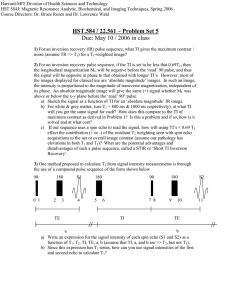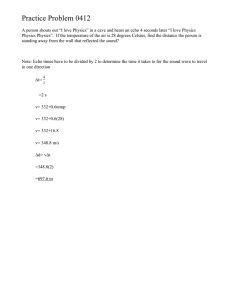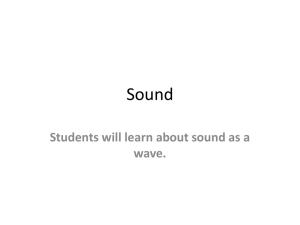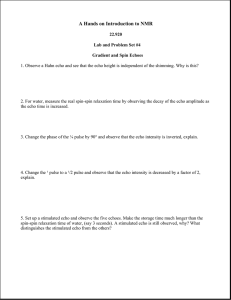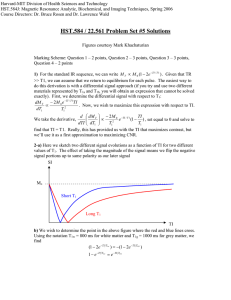Overview Optimizing MRI Protocols 7/27/2004 (SNR, CNR, Spatial Accuracy)
advertisement
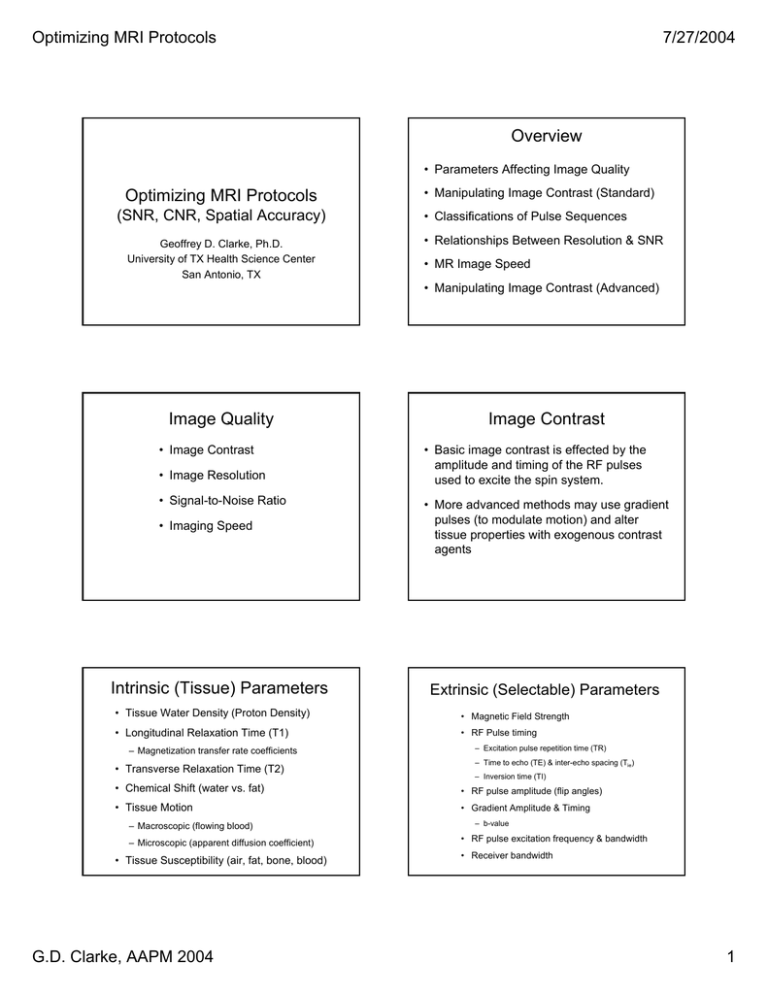
Optimizing MRI Protocols 7/27/2004 Overview • Parameters Affecting Image Quality Optimizing MRI Protocols (SNR, CNR, Spatial Accuracy) Geoffrey D. Clarke, Ph.D. University of TX Health Science Center San Antonio, TX • Manipulating Image Contrast (Standard) • Classifications of Pulse Sequences • Relationships Between Resolution & SNR • MR Image Speed • Manipulating Image Contrast (Advanced) Image Quality • Image Contrast • Image Resolution • Signal-to-Noise Ratio • Imaging Speed Intrinsic (Tissue) Parameters Image Contrast • Basic image contrast is effected by the amplitude and timing of the RF pulses used to excite the spin system. • More advanced methods may use gradient pulses (to modulate motion) and alter tissue properties with exogenous contrast agents Extrinsic (Selectable) Parameters • Tissue Water Density (Proton Density) • Magnetic Field Strength • Longitudinal Relaxation Time (T1) • RF Pulse timing – Magnetization transfer rate coefficients • Transverse Relaxation Time (T2) – Excitation pulse repetition time (TR) – Time to echo (TE) & inter-echo spacing (Tie) – Inversion time (TI) • Chemical Shift (water vs. fat) • RF pulse amplitude (flip angles) • Tissue Motion • Gradient Amplitude & Timing – Macroscopic (flowing blood) – Microscopic (apparent diffusion coefficient) • Tissue Susceptibility (air, fat, bone, blood) G.D. Clarke, AAPM 2004 – b-value • RF pulse excitation frequency & bandwidth • Receiver bandwidth 1 Optimizing MRI Protocols 7/27/2004 Spin (Proton) Density Tissue % Water Tissue Spin Echo Pulse Sequence % Water Liver 70 % Spleen 78% Kidney 75% Brain (GM) 85% Muscle 73% Brain (WM) 75% Heart 78% Tendon 60% RF2 RF1 (rephasing) rephasing) (excitation) TX time Spin Echo FID RX time TE From Akber SF, Physiol Chem Phys & Med 1996; 28: 205-238. Out of Phase Spins (Transverse Magnetization) Spins in Phase Out of Phase Precessing Off-resonance by 17,040 Hz 17, 040 Hz = 17, 040 cycles per second = 360 × 17, 040 degrees/sec 180o ÷ (360o × 17, 040 degrees/sec) = 3 × 10-5 s = 30µs τ τ Dephasing of MR Signal (Transverse Magnetization) Coherent Signal Less Signal No Signal Signal decays exponentially: Mxy = Mo exp [- TE / T2* ] where (Magnetic field 1/T2* = 1/T2 + (γ/2π) * ∆Bo (after 90o rf pulse) inhomogeneity) Rephasing of the MR Signal (Spin Echoes) 4 3 2 1 Signal Dephasing 2 3 Longitudinal (T1) Relaxation Longitudinal relaxation is a recovery process: 4 1 180o pulse 180o Rephased Signal A rephasing radio frequency pulse, changes the phase of the net magnetization vectors by 180o. Thus spins precessing in the same direction come together of moving apart. This forms a SPIN ECHO. G.D. Clarke, AAPM 2004 After 90o pulse - all spin energy is kinetic After 5*T1, Spins lose energy full potential to their of net environment, signal magnetization decreases is reestablished 2 Optimizing MRI Protocols 7/27/2004 Comparison of T1, T2 and for Various Tissues Liver 675+142 Kidney 559+10 Muscle 1123+119 Gray Matter 1136+91 White Matter 889+30 T2(ms) 54+8 84+8 43+4 87+15 86+1.5 Longitudinal Magnetization T1(ms) Mo 1- exp (-TR / T1) 100’s of ms Transverse Magnetization Tissue Time Scale of MR Relaxation Processes exp (-TE/T2*) Akber, 1996 (at 63 MHz) 10’s of ms Manipulating Contrast • The “weighting” of image contrast • Gradient Echo – manipulating image contrast by varying the flip angle Rules of Thumb • TE controls T2 dependence • TR controls T1 dependence • T1 competes with T2 and proton density • Spin Echo – manipulating image contrast with 180o refocusing pulses “PD Weighted” = long TR, short TE • Inversion Recovery – manipulating image contrast with 180o inversion pulses “T2 Weighted” = long TR, long TE Pulse Sequence Classifications “T1 Weighted” = short TR, short TE Spin-Echo Imaging Sequence rf1 Name Gradient Echo Spin Echo Inversion Recovery RF Pulses Contrast Weighting Application One T1 or T2* Fast imaging (3DFT) Two or more T1, PD or T2 conventional Three T1 and T2 Excludes certain tissues RX G.D. Clarke, AAPM 2004 rf2 TX Gsl Gro Gpe Spin Echo time time time time time 3 Optimizing MRI Protocols 7/27/2004 Multi-Echo Acquisitions Spin Echo Imaging – Effect of TR TR = 63 ms, NSA = 16 TR =125 ms, NSA = 8 TR = 250 ms, NSA = 4 TR = 500 ms, NSA = 2 Signal Strength Mo exp(-TE/T2) Mo exp (-TE/T2*) 90o 180o 180o SE1 2*TE TE Bo = 1.5 T o SE2 180 time SE3 3*TE Gslice FOV = 230 mm 256 x 256 st = 4 mm Gread TE = 15 ms TR = 1 s, NSA = 1 TR = 2 s, NSA = 1 Gphase TR = 4 s, NSA = 1 Vlaardingerbroek & den Boer, 1999 TR (s) 4 Multiecho Image Matrix Sensitivity Plots (pulse sequence optimization) 2 Proton Density 104 1.5 Most T1 Weighted 1.2 Most Proton Density Weighted 0.9 Most T2 Weighted 0.6 60 90 T2 0.9 Mo 103 TR (ms) 0.1 Mo 102 10 102 10 TE 30 T1 120 150 180 ms 10310 TE (ms) 102 103 10 102 TE (ms) 103 TE (ms) Inversion Recovery Multi-Slice Imaging 90o 180o 180o 180o Spin Echo TI TE TR Inversion Excitation Refocusing +Mo • Increased efficiency by scanning multiple planes during TR interval M = Mo (1 – 2 exp[-TI/T1]) TI (Crooks L, Arakawa M, Hoenninger J et al. Radiology 1982; 143: 169-174.) -Mo G.D. Clarke, AAPM 2004 4 Optimizing MRI Protocols 7/27/2004 STIR (Short TI Inversion Recovery) Mz Inversion Recovery FSE TR =1400 TI = 100 0 TR =2000 TI = 280 Phase Compensated Fat TR =1400 TI = 280 time Modulus Liver TI Vlaardingerbroek & den Boer, 1999 FLAIR Multiple Sclerosis (FLuid Attenuated Inversion Recovery) Proton Density Mz Brain T2-Weighted FLAIR Mxy Lesion Lesion 0 time CSF Brain Teff TI TR = 2350 TE = 30 time TR=2350 TE= 80 TR=2600 TE=145 TI= 11,000 Rydberg JN et al. Radiology 1994; 193:173-180 Steady-State Free Precession (SSFP or True FISP) Relative Sensitivity of Gradient Echo Sequences TX Field Echo rf RX Slice Select 0.40 Digitizer On Gsl Gpe T2=30 ms FISP 0.20 0.20 Dephasing Phase Encode Phase Rewinder SSFP My/Mo Read Out My/Mo Rephasing Gro 0.40 T2 =200 ms SSFP FISP FLASH 0 0 0 30o 60o 90o Flip Angle 120o 150o 180o FLASH 0 30o 60o 90o 120o 150o 180o Flip Angle Also called FAST, ROAST G.D. Clarke, AAPM 2004 5 Optimizing MRI Protocols 7/27/2004 Cystic Mass Gradient-Echo Imaging Spin Echo TR/TE = 2500/90 NSA =1 5 mm FISP TR/TE = 22/10 NSA =8 8 mm True FISP TR/TE = 16/6 flip = 40o NSA =8 5 mm True FISP TR/TE = 16/6 flip = 70o NSA =8 5 mm Reference: Wehrli, Fast-Scan Magnetic Resonance. Principles and Applications Signal-to-Noise Ratio SNR and Imaging Parameters • Signal-to-noise in an RF coil: S N ∝ v ω o M o ∫ B1 (r ) dV SNR ∝ 4kT BW Rt FOVro FOVph NSA ⋅ ∆z ⋅ M ro M ph BWrx S = signal dV = elemental volume of tissue N = noise k = Boltzman’s constant FOV = field of view ωo = resonant frequency T = patient temperature BW rx = receiver bandwidth ro = read out (frequency encoding) direction Mo = net magnetization BW = receiver bandwidth B1(r) = RF field distribution Rt = total resistance (coil + patient) M = matrix size ∆z = slice thickness n = number of signals averaged ph = phase encoding direction Matched Bandwidth Matched Bandwidth • Bandwidth on ADC1 is limited by finite Tmax & desire to minimize TE1. • T1 weighting and SNR is sacrificed more by T2 decay than by BW • T2-weighted image - lots of time for ADC2, poorer SNR. It would be nice to decrease BW (increase Tmax) Mugler & Brookeman, Magn Reson Imag 1989; 7:487-493. G.D. Clarke, AAPM 2004 ADC 90o ADC t 180o TE1 ≈ 20 ms TE2 ≈ 60-80 ms Mugler & Brookeman, Magn Reson Imag 1989; 7:487-493. 6 Optimizing MRI Protocols 7/27/2004 Matched Bandwidth = Unmatched Distortion T1W Chemical Shift • Chemical shift (fat-water) ~3.5 ppm T2W – At 1.5T: ∆f fat − water = 3.5 × 10 −6 ⋅ 42.6 MHz ⋅1.5T ≅ 220 Hz T – At 0.5T: ∆f fat − water = 3.5 ×10 −6 ⋅ 42.6 MHz ⋅ 0.5T ≅ 73 Hz T • ↓ field strength …. ↓ chemical shift • Smaller BW on T2W image leads to increased image distortion Chemical Shift Artifact • Occurs in • Conventional SE – Phase encode direction σ σ = standard deviation of the background signal (the noise) • Echo-Planar – Fat Pre - Saturation – STIR sequence (I a − I b ) CNR = n – Readout direction • Controlled by Contrast-to-Noise Ratio Chemical shift artifact seen in axial image of kidney Steady state free precession (SSFP) Signal is produced by rapidly applying balanced gradients and RF pulses. Use to maximize the overall signal. FIESTA (fast imaging employing steady state acquisition) Balanced FFE (fast field echo) True FISP (fast imaging with steady precession) n = number of signals acquired Ia,Ib = signal intensities from tissues “a” and “b” IR Turbo-FLASH 180o α α α α α α α FID Train (one for each image line) TI TR Hinton et al. Invest Radiol 2003; 38:436 G.D. Clarke, AAPM 2004 7 Optimizing MRI Protocols 7/27/2004 FSE Pulse Sequence 3D FLASH vs. 3D Turbo FLASH RF Gro Gpe Overall Signal Tie Echo IR Turbo FLASH TI = 500 ms, TR/TE = 10/4.5 NSA =1, flip = 10o Things That have “Blurry” point spread functions are “Sharp” in the Image K-space Center of K-space FLASH TR/TE = 12/4.5 NSA = 1, flip = 8o ETL = Echo Train Length FSE Point Spread Function Depends on T2 FT Image Space Effect of Echo Spacing SE FSE FSE Fat Sat Multi-Shot EPI Pulse Sequences Echo 2 Echo 1 Echo 3 Echo 4 Spoiler ES = 60 ms, TF =3 FSE FSE Slice Select ES = 30 ms, TF =7 Blip 2 Blip 3 Blip 4 FSE Start Blip Spoiler Rewind ES = 15 ms, TF =15 ES = 13 ms, TF =20 ES = 10 ms, TF =27 Signal-to-noise decreases for short T2 tissues (gray & white matter) leading to a decrease in spatial resolution Vlardengerbrook & den Boer, 1999 G.D. Clarke, AAPM 2004 Preparatory (Fat Sat) RF Dephase/ Excitation Rephase TR ts Tie Ttot 8 Optimizing MRI Protocols 7/27/2004 Comparison of EPI and SE Magnetization Transfer PROTON SPECTRUM 0 Frequency (Hertz) “Free” Water Lipids Single shot EPI TE =80 128x128; 120 ms Nine-shot EPI TR 3000, TE 21 252x256; 1:06 Gradient Echo with MTC Pulse 0 T2-weighted SE TR 2400, TE 80 192x256; 7:44 “Bound” Water 217 Hz Frequency (Hertz) 1500 Hz Magnetization Transfer Contrast Off-resonance rf pulse RF excitation Multislice FSE: TX Digitizer On Field Echo RX Slice Select Gsl Rephasing Spoilers Read Out Crushers or Spoilers Dephasing Gro Phase Encode Gpe Slice thickness - RF bandwidth Magnetization Transfer Contrast Enhances T-2 Weighted Appearance Crafted RF Pulses sin x A sinc function ( x ) envelope on the r.f. pulse produces a nearly square excitation profile of the phantom….. – thinner slices require longer RF pulses FT – ↓ ∆z ↓ ∆ω Bandwidth = 1 period G.D. Clarke, AAPM 2004 time FT FT BW frequency tp 9 Optimizing MRI Protocols 7/27/2004 Cranial Nerves MRI Slice Thickness • Signal ramps have a slope of 10:1 • Signal from ramp is 10 x slice thickness • Two ramps are used to compensate for inplane rotation of the phantom • Phantom does not compensate for tilting backwards or swaying left-right 10 mm slice Frequency Encoding & FOV Phase Encode Gradient – The field of view (FOVx) is determined by the range of frequencies in the x- axis which are sampled Bandwidth FOVx = The maximum phasephase-encoding gradient is : G γ ⋅ Gx – The receiver bandwidth is not the same as the RF bandwidth ph − max = 2π γ BW π N = ⋅ FOV γ FOV ⋅ Ty The phasephase-encoding gradient increment is : ∆G ↑ FOVx – FOV must be sufficient to cover all tissue in the slice to avoid aliasing ph = π 1 ⋅ γ FOV ⋅ Ty • Note that a factor of two is gone from Gph-max because Gph runs from- Gph=max to Gph=max CHESS Sampling the Signal 900sat – Each signal is digitally sampled to produce one line in the k- space matrix 900 1800 RF ∆k x = γ ⋅ Gx ∆t x MHz mT ⋅ ⋅ msec T m cycles = m 1 ∆k x = FOVx ⋅ where FOV is the desired field of view • ↑ BW ↑ FOVx • ↓ Gx 3 mm slice Gspoiler ∆k x = G.D. Clarke, AAPM 2004 Signal • This is typically accomplished by preceding a SE or FSE sequence with a 90o pulse that is frequency, not spatially, selective. 10 Optimizing MRI Protocols 7/27/2004 Spatial Saturation Fat Suppression Blood Flow 90o Sat Pulse 90o-180o SE Pulses T1W images without (left) and with (right) fat suppression. Spatial Saturation Gadolinium Contrast Agents • GD-DTPA, Gd-DOTA, Gd-HP-DO3A: a. No Sat Pulse b. Inferior Sat Pulse c. Superior Sat Pulse d. Inferior and Superior Sat Pulses the old standards, generally diffusable but not in brain due to Blood Brain Barrier – In low doses decrease T1 – In higher doses decrease T1 and T2* NEW INTRAVASCULAR AGENTS • Blood pool agents – Magnetic iron oxide particles – Bind serum albumin, have higher relaxivity GE Signa Applications Guide, Vol 1 Gadolinium Contrast Agents Normal T-1 Dynamic Contrast Studies weighted Images With Gd Contrast Meningioma • Dynamic study of breast tumor • Curves denote difference between uptake of normal glandular tissue & lesion Vlaardingerbroek & den Boer, 1999 G.D. Clarke, AAPM 2004 11 Optimizing MRI Protocols 7/27/2004 Diffusion Weighted Imaging: Prototype Pulse Sequence Attenuation Due to Diffusion δ A(TE ) = A(0) exp[−γ 2G 2 Dappδ 2α 2 (∆ − )] 4 Where: α=π/2; G is amplitude of diffusion sensitive gradient pulse; δ is duration of diffusion sensitive gradient; ∆ is time between diffusion sensitive gradient pulses; Dapp is the apparent diffusion coefficient The b-value 90o 180o time G G δ δ ( b = γ 2G 2δ 2 ∆ − δ ∆ 3 ) Stejskal EO & Tanner JE, 1965. 42: 288-292 Diffusion EPI Pulse Sequence • Controls amount of diffusion weighting in image RF 90o • The greater the b-value the greater the area under the diffusion-weighted gradient pulses FE 180o SS Gx Gx PE – longer TE – stronger and faster ramping the gradients MR signal ~100 ms Diffusion Imaging of Infarcts SE Echo Planar TE = 80 ms Biorelaxometry SE Echo Planar b = 1205 s mm-1 Koenig, et. al, 1983 G.D. Clarke, AAPM 2004 12 Optimizing MRI Protocols Specific Absorption Rate (SAR) • The patient is in an RF magnetic field that causes spin excitation (the B1 field) • The RF field can induce small currents in the electrically conductive patient which result in energy being absorbed. • The RF power absorbed by the body is called the specific absorption rate (SAR) • SAR has units of watts absorbed per kg of patient • If the SAR exceeds the thermal regulation capacity the patient’s body temperature will rise. SAR Effects on Pulse Sequences 7/27/2004 Scan Parameters Effecting SAR • Patient size: SAR increases as the patient size increases – directly related to patient radius • Resonant frequency: SAR increases with the square of the Larmor frequency (ωo) • RF pulse flip angle: SAR increases as the square of the flip angle (α • Number of RF pulses: SAR increases with the number of RF pulses in a given time Uniformity at 3 Tesla 1.5T • Decrease number of slices per study • Requires decreased flip angles, even in gradient echo sequences 3T • Forces increases in TR • Limits use of Fast Spin Echo imaging • B1 field maps in a conductive saline phantom (18 cm diameter) RL Greenman et al. JMRI 2003, 17(6): 648648-655 Summary • RF pulses can be crafted to select slices • RF pulse timing (TE, TR & TI) is used to manipulate soft tissue contrast in MR images • Gradient echo imaging with partial flip angles is faster than spin echo imaging • Spin Echoes correct for poor magnetic fields • Inversion recovery can be used to get rid of fat or CSF from images • Contrast agents are used to manipulate tissue T1 G.D. Clarke, AAPM 2004 Summary • Presaturation schemes can effect flow, chemical shift and T1-weighted contrast • Fast imaging methods are often applied to imaging physiology as well as anatomy • Typically, SNR is reduced with increases in resolution, contrast and imaging speed • Various image parameters will have to be adjusted for each magnetic field strength 13

